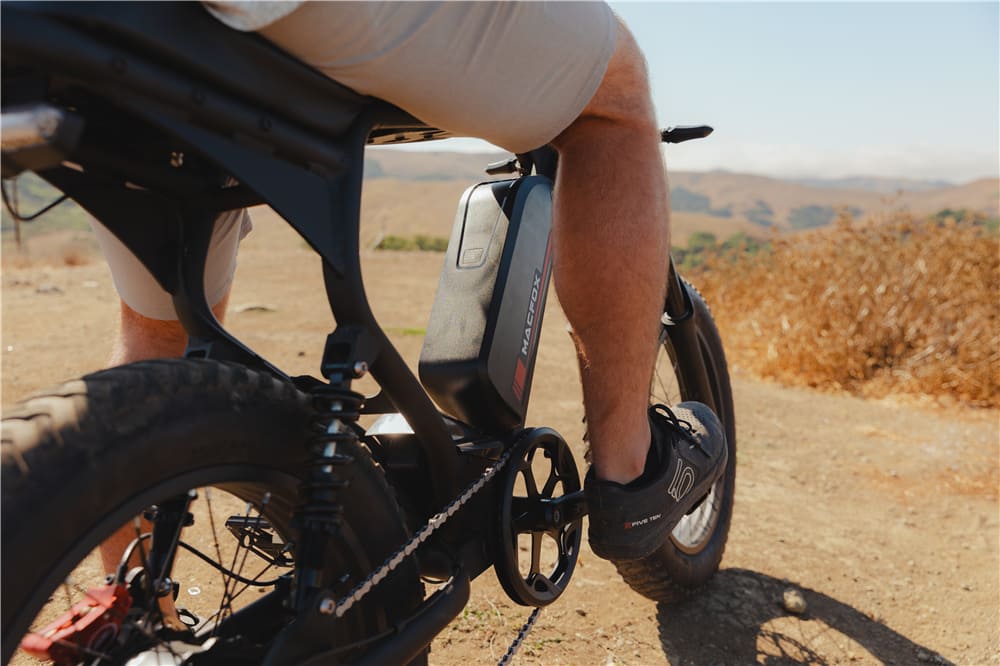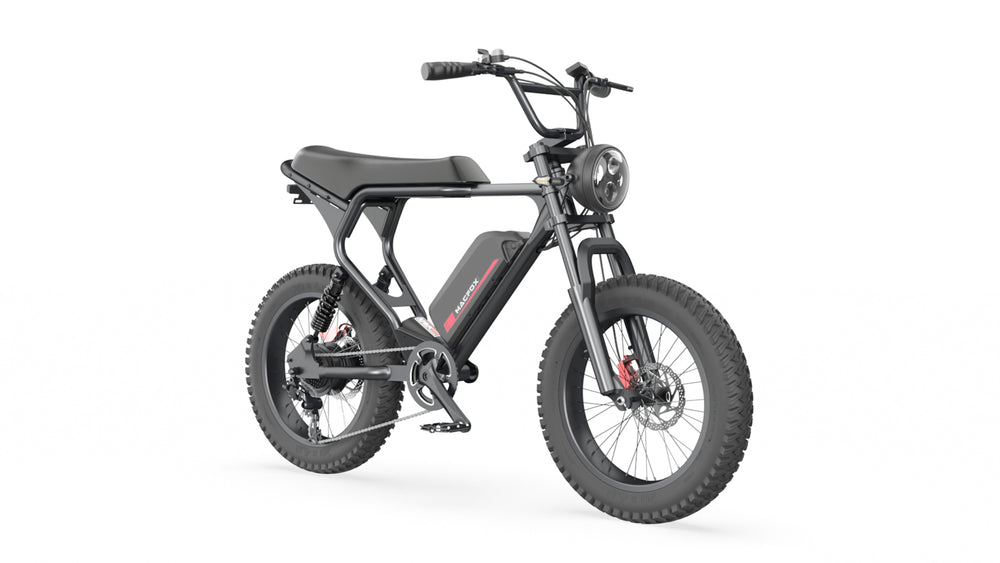Electric bikes (e-bikes) have revolutionized how we think about cycling. By combining traditional cycling with an electric boost, e-bikes provide an amazing blend of traditional biking with electric assistance that makes hills easier to conquer and distances more manageable. When selecting an e-bike that's right for you, motor placement can have a dramatic impact. Most motors on e-bikes are mounted either front-wheel or rear-wheel; each configuration offers advantages and disadvantages that should help narrow your search for your perfect ride.
Macfox recently launched two exciting e-bike models that showcase rear-geared hub motors in action: the X1S electric commuter bike and the X2 off road electric bike. Both feature rear-geared hub motors, perfectly aligned with today’s e-bike production trends that prioritize traction, power and a natural riding feel.
Front Motor Advantages

Optimized Weight Distribution: Front-mounted motors help achieve more even weight distribution across an e-bike, especially when the battery is located at the back. This balance can counterbalance and enhance stability for comfortable commuting; an example would be Macfox's electric commuter bike, which uses a geared hub motor in front of it to achieve this optimal balance and ease of handling in urban environments.
Cost-Effectiveness and Accessibility: Front motor e-bikes generally feature simpler mechanical designs that reduce production and retail costs, providing budget-minded consumers with easier entry points into the e-bike market. Furthermore, manufacturers like Macfox can produce top-quality electric bikes at more accessible price points.
Maintenance and Repairs Made Easier: By situating the motor on the front wheel, riders find it much simpler and easier to perform maintenance and repairs on their bike's drivetrain. This arrangement keeps the wear on the wear-prone rear wheel unaffected by the motor and makes tire changes, brake maintenance, and drivetrain repairs much simpler - further decreasing the maintenance burden on riders.
Macfox X2
$1,699.00 – $2,198.00Front Motor Disadvantages
Difficulties With Traction and Control: One major drawback of front motor e-bikes lies in their reduced traction. Since most riders' weight is balanced between the front and rear wheels, a front motor may struggle to provide adequate grip, especially on loose, wet, or steep surfaces; this may result in its front wheel slipping under acceleration, which could compromise control and safety during rides.
Impacted Handling and Steering: Integrating a motor into the front wheel adds extra weight, changing its handling dynamics. Riders might find the steering less responsive at low speeds or when taking tight turns; this change requires an adjustment period for riders to feel secure in urban settings where agility is crucial.
Aesthetic and Design Considerations: Some cyclists have aesthetic preferences regarding where the motor should be placed on their bike. A front motor can often be more visible and disrupt its traditional silhouette; therefore, it is not appealing to all riders. Companies such as Macfox are continually innovating to integrate motors seamlessly into bike designs while minimizing visual impact, and producing sleek, attractive appearances.
Related Reading: What Do Watts Mean on a Electric Bike
Rear Motor Advantages
Superior Traction and Performance: The rear motor configuration maximizes the natural weight distribution between bike and rider during acceleration and climbing, thereby directly enhancing rear wheel traction when needed - specifically the Macfox X2 off road electric bike, which uses gears on the rear hub hub motors, thereby optimizing rear-wheel drive for traction stability on uneven and challenging terrain. A great choice for adventurers!
Enhance Riding Dynamics: E-bikes equipped with rear motors often offer a more natural riding experience, closely replicating that of traditional non-electric bicycles. Their push from behind often feels intuitive for most cyclists and makes the transition between conventional and electric biking seamless and steady at higher speeds. Furthermore, this setup ensures a more controlled acceleration experience at higher speeds for a smoother acceleration experience overall.
Rear Motors Can Manage Higher Power and Torque: Rear motors tend to be better at managing higher levels of power and torque compared to front motors, making them well-suited for performance-focused tasks like off-road adventures or carrying heavy loads. Their placement ensures the additional power doesn't compromise handling, which is an ideal solution.
Macfox X1S
$9,99.00 – $1,398.00Rear Motor Disadvantages
Complexity and Increased Cost: Integrating an e-bike's rear motor with its drivetrain adds another level of complexity in terms of both the manufacturing process and design. This leads to higher costs for manufacturers and consumers alike due to the need for more sophisticated components, consequently increasing the overall price of an e-bike.
Maintenance Challenges: Due to all the components being located together in one area, maintenance and repair tasks become more involved and time-consuming. Tasks such as changing tires or fixing chains become more involved when fitted with motors in their rear wheel - potentially necessitating professional assistance as well as higher costs and longer downtime for riders.
Weight Distribution and Handling: While rear motors improve traction, they can shift the bike's weight distribution towards its rear end, altering the balance and handling when riding at lower speeds or through tight corners. Riders might need to adapt their riding style in order to adapt to this rear-heavy feel - something to bear in mind for newcomers or those preferring a more traditional balance when considering E-biking as a form of transportation.

Making Your Choice
When faced with making the difficult choice between a front-motor e-bike and a rear-motor e-bike, several key considerations should help guide your decision-making. Understanding them fully will enable you to select an e-bike that not only meets but exceeds all your riding expectations.
Consider Your Riding Terrain and Conditions: Your riding terrain and conditions should play a vital role when choosing an e-bike. If most of your adventures take place off-road or in hilly terrain, a rear-mounted e-bike with excellent traction and power may be the best choice; enthusiasts may prefer models like the Macfox Off-Road E-Bike, which is designed for easy Designed to handle challenging terrain. On the other hand, front-mounted motorcycles can offer a more balanced and cost-effective solution for a balanced commute on paved roads - making front-mounted bikes the perfect commuting solution!
Assess Your Need for Power and Performance: Before purchasing an electric bike, take the time to assess what performance expectations you have from it in terms of power and performance. Do you require extra torque for steep inclines, or are you after gentle assistance on flat terrains? Rear motor e-bikes typically deliver more power and are better at handling demanding conditions compared with their front motor counterparts; thus, if performance is paramount for off-road riding or transporting cargo, it may be worthwhile investing in one with this feature.
Assess Your Budget Constraints: Your budget constraints can often play a decisive role. Front motor e-bikes may be more affordable in terms of both initial purchase price and long-term maintenance costs, making them a good value choice without significantly impacting quality or experience. If budget restrictions are tight, front-motor e-bikes might provide the ideal solution.
Riding Experience and Comfort: Consideration of personal preference is of utmost importance in selecting an e-bike that best meets your riding style and comfort needs. Test out both front and rear motor options before selecting which you find more intuitive and comfortable during rides. Consider how the bike handles, its weight distribution during rides, and whether or not its motor's response aligns with your riding style.
Maintenance and Upkeep: Be honest with yourself about your comfort with performing maintenance tasks or handling potential repairs. If simplicity and ease of maintenance are most appealing to you, opting for a front-motor e-bike might be preferable; otherwise, rear-motor setups might offer greater performance potential with their complexity and increased maintenance needs. If this is not an issue for you, performance power may lead to choosing one of these vehicles over others.
Long-Term Considerations: As your needs and preferences change over time, be mindful that a front motor e-bike may suit your current urban commuting needs now, but if your ambitions include exploring more adventurous riding later, investing in a rear motor e-bike from the outset could save you from needing an upgrade later.
Finding an electric bike to suit your personal preferences, needs, and budget requires carefully considering all relevant factors. Both front and rear motor options offer distinct advantages; making an informed choice will ultimately depend on how you intend to use your e-bike and what benefits its features can bring you. Remember: Your goal should be finding an e-bike that brings joy, comfort, and convenience while adding to your overall cycling experience. Whether you opt for a front or rear motor, you are simply joining an important movement towards more sustainable means of transportation!
Conclusion
Overall, front-motor e-bikes vs. rear-motor e-bikes don't offer a simple solution; rather, it comes down to personal preference, riding needs, and budget. Whether your goals are simplicity and cost efficiency, or performance and traction - there's an e-bike motor arrangement to suit you. By understanding the nuances of each option, as well as Macfox's innovative models, you'll be well-positioned to choose the e-bike that provides the best riding experience. So why wait? go! Get out there - take over!
FAQs
Can I convert a regular bike into an e-bike using either front or rear motor kits?
Yes, conversion kits for front and rear wheel installations are available depending on your bike, budget and desired riding experience. It all boils down to choosing what makes the most sense for your individual circumstances and preferences.
Will a motor e-bike feel significantly heavier than one with the front motor?
No. Though motor and battery placement may affect weight distribution, modern e-bikes are designed to optimize balance and handling so as to minimize perceived differences between them in weight distribution.
Can I switch between front and rear motors on my e-bike if my mind changes?
E-bikes typically feature either a front or rear motor, and switching between them may not be straightforward due to how each bike's build and wiring work. Thus, it is wise to select which motor placement best meets your needs when first purchasing your e-bike.




















